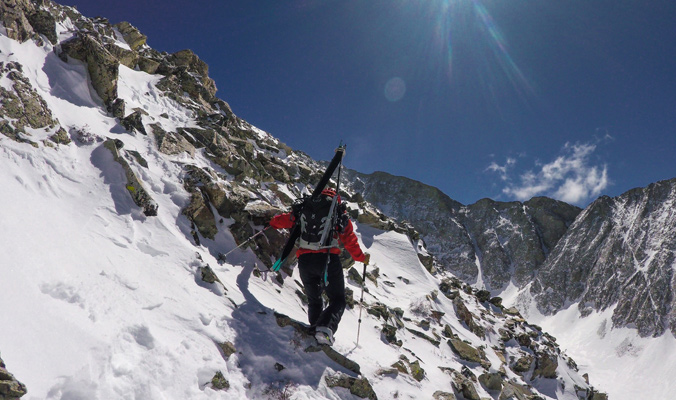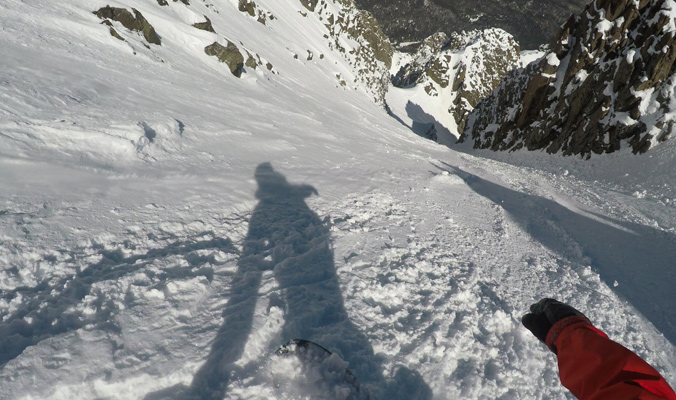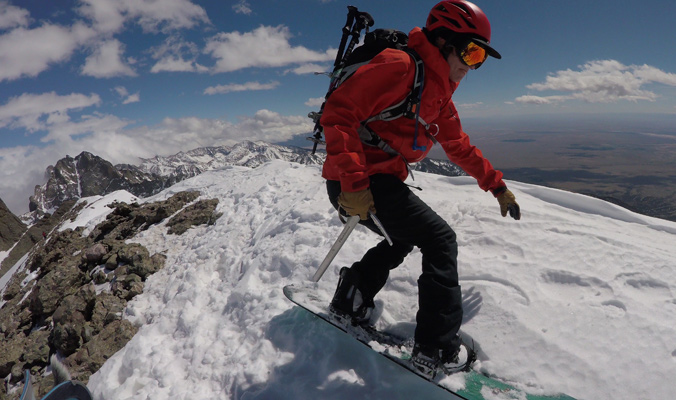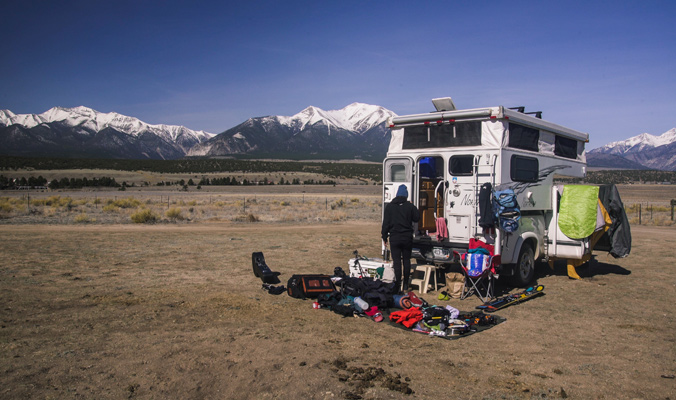After ending a decade-long career as a pro freeride snowboarder, Laura Hadar was in search of a new challenge. Luckily, as Aspen and Carbondale, Colorado residents, Hadar and her partner, Nicky Anastas, have access to some of the tallest peaks in the U.S. After climbing and riding the 14,000-foot Castle Peak in the spring of 2016, Hadar embraced the challenge of becoming the first female splitboarder to ride all of Colorado’s 14ers. Since then, Hadar and Anastas have tackled 21 peaks, with 37 remaining.
Hadar took a minute to chat with us about the project’s impact on her life, her progress so far and her plans to share the journey in the future.

Laura Hadar makes her way toward 14,037-foot Little Bear Peak. [Photo] Nicky Anastas
Laura Hadar: Riding Castle Peak was the first time that I hiked a really steep line and snowboarded down it. I was more used to typical backcountry travel—mostly via snowmobile, heli and a little bit of splitboarding. Castle was the first 14er I did, and it got me excited to splitboard other tall peaks. After Castle, Nicky and I did Maroon Peak. That was when I thought, “Wow, I don’t think any girls have snowboarded this.” We asked around, and we didn’t think that any girls had snowboarded the Maroon Bells either. Once we decided to go for North Maroon, the seed was planted in my head. We were camping up at Crater Lake, and I thought, “Maybe this is what I should do.” I was looking for something in my life—looking for a career at the time—and I think that you can take the dirtbag out of the mountains, but you can’t take the mountains out of the dirtbag.
My whole life, I’ve been interested in doing what people aren’t doing. I always joke that I was never the best, but I was always the first. For me, I don’t see any girls out here doing this on a splitboard. So I decided, “If I don’t do this, who is and when?” Right now, there aren’t many women splitboarders. The field is definitely growing, but it’s still a pretty small pool of us who are getting out there. Also, in splitboarding, most people want to ride powder, and that’s not really what ski-mountaineering is about. It’s about the journey of getting to a summit and getting back down from it. If you’re lucky, you get good conditions, but most of the time you’re getting really variable snow, especially in the higher alpine.

Hadar skins toward Chicago Basin and Windom Peak,14,082 feet, and Sunlight Peak, 14,059 feet. [Photo] Nicky Anastas
LH: Yeah, it helped a lot, but it’s still the least snowboarding I’ve ever done while being on my snowboard.
BCM: You mentioned that what you’re doing is still super uncommon for boarders. Are there any benefits or challenges when it comes to doing a mission like this on a splitboard versus skis?
LH: For the most part it’s similar to doing it on skis. In the basin on Blanca Peak, there was one time that I resented being on my board. There was a little apron right off the summit and then maybe 10 to 15 feet of rock. Nicky—a tele skier—was able to side step down it, and I was too stubborn to take my board off, so there was no way for me to step down. I had my ice axe out and my stomach facing the snow on my toeside edge, so I used my ice axe in the rocks for leverage while I scooted my snowboard down. It was the most ridiculous and ugly thing in the world.

Laura rides a couloir on 14,150-foot Mt. Sneffels. [Photo] Laura Hadar
BCM: How many 14ers have you and Nicky tackled so far?
LH: There are fifty-four official peaks and four unofficial points that share ridgelines that make up Colorado’s 14ers. We’ve already done two of the unofficial points so we just said, “Screw it, lets do all 58.” We started last spring and met up to do Castle. Afterward, we summited Maroon and North Maroon. Those peaks—North Maroon especially—were considered to be in the top five or top eight of the more technical routes. That was what gave us a lot of motivation and confidence, because we realized if this was one of the more technical peaks, there will be a lot that won’t be as bad. So we did five that first spring: Castle, Maroon, and then Torrey’s and Quandary, which are both really mellow. On Torrey’s, we did the Dead Dog Couloir, which was really fun. Both Nicky and I have three jobs, so we didn’t get much snowboarding done in the winter. We started in April and went until the first of June. In that time, we got 16 peaks. We were actually on a pretty relaxed schedule, averaging a peak about every three or four days.

Hadar makes her way up the Class 4 crux of Mt. Sneffels. [Photo] Nicky Anastas
LH: La Plata was one of my favorites. We got great spring corn, and it was a really easy approach. Little Bear was probably the most exciting line we did this spring—exciting as in frightening. That one had a really long approach. We hiked in five or six miles with all of our camping, snow and camera gear. We had to traverse a ridge with loose rock mixed with snow, which is just about the worst combination in the world, and we were above a ton of exposure for at least a mile, but that wasn’t even the gnarly part. We got to an hourglass, which is a notoriously dangerous spot, because the whole face funnels into an area no more than seven feet wide. It felt like the whole day was a no-fall zone. We got to the top, and Nicky led us a little bit off route and landed us on the edge of the peak with the wind howling. We had to do technical climbing with crampons on and ice axes. We were both pretty scared and definitely excited to get down and back to camp safely.

Hadar dives off 14,081-foot Challenger Point. [Photo] Nicky Anastas
LH: Our goal is to do a documentary that will be a story about how we came to this place in our lives and what it means for us to be in the mountains. I was really going through a hard time [when I started this project]. I had just ended a decade-long career as a professional snowboarder; I left this very successful business that I helped start in Salt Lake; and I moved home. It was a lot of change all at once that kind of threw me mentally. I struggled to figure out what I was doing next. I’ve always been a long-term-goal person who works toward something bigger, and it was really confusing for me to not have that in my life all of a sudden. I tried to get away from the mountains and was in Portland, Oregon for a while. But as soon as we did Castle, a cloud that had been following me lifted. I remember that moment; it was the first time in a long time that I felt complete. I think that’s going to be what the movie is about.

Anastas and Hadar’s home for two months in front of the Collegiate Peaks. {Photo] Nicky Anastas









GET IT GIRL!